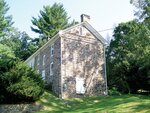


John Holcombe, father of Richard, was the first settler in the Lambertville area. A Quaker born in England and formerly of Abington, John purchased 350 acres in 1705 that included the northern half of today’s Lambertville. Further acquisitions brought his holdings to more than 1,800 acres. In 1707, John married Elizabeth Woolrich, also of Abington, and they moved soon thereafter to the Lambertville area where they raised six children.
At age 17, Richard inherited land from his father when he died in 1743. Eight years later, Richard and his first wife, Mary Harvey, had their first of two children, a daughter, followed by a son in 1755.
To accommodate his growing family about a year later, Richard built the two-story stone house that exists today. Tragically, just four years later in 1760, both his wife and five-year-old son died. Their daughter was only nine at the time.
In 1767 Richard and his second wife, Ann Atkinson, had the first of their five children at the house. Richard lived there for about 27 years when he died in 1783 at age 57. Inheriting the house was his only surviving son, John Holcombe III.
As Lambertville’s oldest house, circa 1756, the Richard Holcombe House certainly merits preservation and recognition. Its historical importance is far greater, however, because it was General George Washington’s headquarters on two occasions during the Revolutionary War.
General Washington’s first stay at the Holcombe House was in late July 1777. He was not on a march with his army, which had camped miles away, nor was he planning a battle. Instead, he was awaiting word on where the British army was headed after leaving New York Harbor by boat. When he learned that the army was sailing south to the Delaware Bay, Washington concluded that the British were headed to Philadelphia. With the intent of protecting the colonies’ largest city, Washington ordered his army to cross over to Pennsylvania on July 31. (Washington and a few aides would have crossed the Delaware at nearby Coryell’s Ferry.) Eventually, Washington and his army engaged the British army at the Battle of Germantown (now part of Philadelphia) in early October.
General Washington again stayed at the Holcombe House in late June 1778. This time he was leading his army on a march in hot pursuit of the British. Upon learning that the British army was leaving Philadelphia to march toward New York, Washington ordered his now better-trained army to leave its winter quarters at Valley Forge to intercept the British army in the Province of New Jersey. The route he chose was Old York Road to Coryell’s Ferry. There, his army of over 10,000 crossed the Delaware and camped about three miles outside of today’s Lambertville. The army marched on and fought the British on June 28 at the Battle of Monmouth, the largest artillery battle of the Revolutionary War.
Several soldiers and aides would have accompanied Washington at the Holcombe House including Alexander Hamilton, his closest aide. Richard Holcombe gave Washington a receipt for 38 dinners over June 21-22, 1778, so it is possible that his entourage numbered as many as 19 people on this second visit. With Richard Holcombe’s family of eight, the 1,200-square-foot, two-bedroom house would have been very crowded over those two days and nights.
The Holcombe House and surrounding open space remained in the Holcombe family until 2021, when Ed Closson, a seventh-generation descendant, sold the house and remaining eight acres to the City of Lambertville. The historic house and a newly installed interpretive sign are located at North Main Street and Philips Barber Road. The well-landscaped grounds, appropriately named Holcombe Park, are open to the public.
Tom Ogren is a Lambertville Historical Society board member.
“Heralding Our History” is a weekly feature. Each month, the Herald delves into the history of one of its towns.
Join our readers whose generous donations are making it possible for you to read our news coverage. Help keep local journalism alive and our community strong. Donate today.